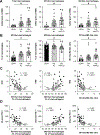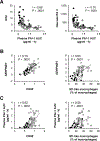Associations Among Adipose Tissue Immunology, Inflammation, Exosomes and Insulin Sensitivity in People With Obesity and Nonalcoholic Fatty Liver Disease
- PMID: 34004161
- PMCID: PMC8900214
- DOI: 10.1053/j.gastro.2021.05.008
Associations Among Adipose Tissue Immunology, Inflammation, Exosomes and Insulin Sensitivity in People With Obesity and Nonalcoholic Fatty Liver Disease
Abstract
Background and aims: Insulin resistance is a key factor in the pathogenesis of nonalcoholic fatty liver disease (NAFLD). We evaluated the importance of subcutaneous abdominal adipose tissue (SAAT) inflammation and both plasma and SAAT-derived exosomes in regulating insulin sensitivity in people with obesity and NAFLD.
Methods: Adipose tissue inflammation (macrophage and T-cell content and expression of proinflammatory cytokines), liver and whole-body insulin sensitivity (assessed using a hyperinsulinemic-euglycemic clamp and glucose tracer infusion), and 24-hour serial plasma cytokine concentrations were evaluated in 3 groups stratified by adiposity and intrahepatic triglyceride (IHTG) content: (1) lean with normal IHTG content (LEAN; N = 14); (2) obese with normal IHTG content (OB-NL; N = 28); and (3) obese with NAFLD (OB-NAFLD; N = 28). The effect of plasma and SAAT-derived exosomes on insulin-stimulated Akt phosphorylation in human skeletal muscle myotubes and mouse primary hepatocytes was assessed in a subset of participants.
Results: Proinflammatory macrophages, proinflammatory CD4 and CD8 T-cell populations, and gene expression of several cytokines in SAAT were greater in the OB-NAFLD than the OB-NL and LEAN groups. However, with the exception of PAI-1, which was greater in the OB-NAFLD than the LEAN and OB-NL groups, 24-hour plasma cytokine concentration areas-under-the-curve were not different between groups. The percentage of proinflammatory macrophages and plasma PAI-1 concentration areas-under-the-curve were inversely correlated with both hepatic and whole-body insulin sensitivity. Compared with exosomes from OB-NL participants, plasma and SAAT-derived exosomes from the OB-NAFLD group decreased insulin signaling in myotubes and hepatocytes.
Conclusions: Systemic insulin resistance in people with obesity and NAFLD is associated with increased plasma PAI-1 concentrations and both plasma and SAAT-derived exosomes. ClinicalTrials.gov number: NCT02706262 (https://clinicaltrials.gov/ct2/show/NCT02706262).
Keywords: Cytokines; Insulin Resistance; Macrophages; PAI-1; T Cells.
Copyright © 2021 AGA Institute. Published by Elsevier Inc. All rights reserved.
Figures






References
-
- Klein S, Wadden T, Sugerman HJ. AGA technical review on obesity. Gastroenterology 2002;123:882–932. - PubMed
-
- Stefan N, Haring HU, Cusi K. Non-alcoholic fatty liver disease: causes, diagnosis, cardiometabolic consequences, and treatment strategies. Lancet Diabetes Endocrinol 2019;7:313–324. - PubMed
-
- Belfort R, Harrison SA, Brown K, et al. A placebo-controlled trial of pioglitazone in subjects with nonalcoholic steatohepatitis. N Engl J Med 2006;355:2297–307. - PubMed
Publication types
MeSH terms
Substances
Associated data
Grants and funding
LinkOut - more resources
Full Text Sources
Other Literature Sources
Medical
Molecular Biology Databases
Research Materials
Miscellaneous

